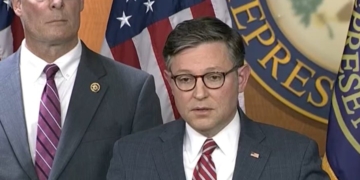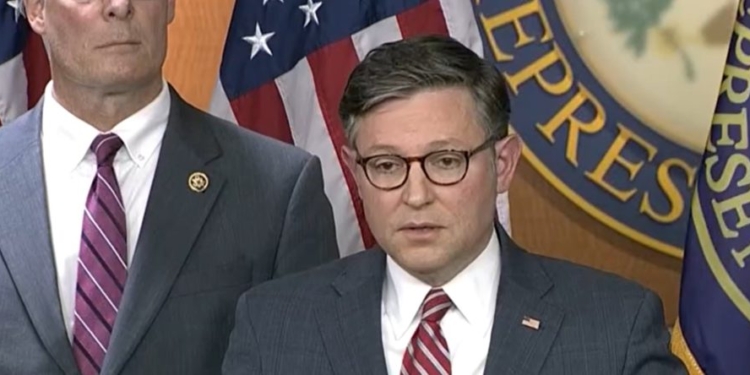The median age in the United States in 2023 was 39.1 years, according to the Census Bureau. That means that approximately half the people in this country were born in 1984 or later.
What was happening four decades ago when about half America’s current population started coming into the world?
In 1984, then-President Ronald Reagan was reelected. At that time, this nation’s greatest foreign policy concern was the ongoing Cold War with the Soviet Union. On June 12, 1987, Reagan visited West Berlin, which was surrounded by Soviet-controlled East Germany and separated by a wall from Soviet-controlled East Berlin.
Reagan famously gave a speech that day in front of where that wall blocked access to an 18th-century structure known as the Brandenburg Gate.
“We come to Berlin, we American presidents, because it’s our duty to speak, in this place, of freedom,” he said.
“Behind me stands a wall that encircles the free sectors of this city, part of a vast system of barriers that divides the entire continent of Europe,” said Reagan.
He then issued an unambiguous challenge to then-Soviet Communist leader Mikhail Gorbachev.
“There is one sign the Soviets can make that would be unmistakable, that would advance dramatically the cause of freedom and peace,” Reagan said. “General Secretary Gorbachev, if you seek peace, if you seek prosperity for the Soviet Union and Eastern Europe, if you seek liberalization: Come here to this gate! Mr. Gorbachev, open this gate! Mr. Gorbachev, tear down this wall!”
Two years later — on Nov. 9, 1989 — German citizens started tearing down the wall. Reagan’s successor, President George H. W. Bush, was in office then. But it was Reagan’s vision and persistence that brought the Cold War to an end.
At the end of Jan. 1981 — the month Reagan took office — the total debt of the federal government was $934,073,000,000, according to the Treasury Department’s Monthly Statement of the Public Debt. By the end of June 1987, the month Reagan called for destruction of the Berlin Wall, it had risen to $2,309,296,000,000. At the end of Nov. 1989, the month the wall came down, it was $2,923,589,000,000 — or $1,989,516,000,000 more than it was the month that Reagan took office, and $614,293,000,000 more than it was the month when Reagan called for Gorbachev to tear down the wall.
In Nov. 1989, when the Berlin Wall came down, 117,912,000 people were employed in the U.S., according to the Bureau of Labor Statistics. The $2,923,589,000,000 in debt the federal government held at the end of that month equaled approximately $24,795 per each one of those workers.
What has happened to the debt since then?
As of the end of this August, according to the Monthly Statement of the Public Debt, the total federal debt was $35,256,057,000,000. That is about 12 times as much as the $2,923,589,000,000 in debt the federal government held the month the Berlin Wall came down.
This August, there were 161,434,000 people employed in the U.S. The $35,256,057,000,000 in federal debt at the end of that month equaled approximately $218,393 per each of those workers.
On Jan. 20, 2021, when President Joe Biden and Vice President Kamala Harris were inaugurated, the total federal debt was $27,751,896,236,414.77, according to the Treasury Department. As of this Monday, it was $35,346,469,569,597.74.
So far, under the Biden-Harris administration the federal debt has increased by approximately $7,594,573,333,182.97.
That less-than-four-year increase in the debt is more than two-and-a-half times as much as the total debt that was accumulated in the more than two centuries that passed between the Declaration of Independence and the fall of the Berlin Wall.
Where are we headed now?
“If current laws governing taxes and spending generally remained unchanged, the federal budget deficit would increase significantly in relation to gross domestic product (GDP) over the next 30 years,” the Congressional Budget Office wrote in its “Long-Term Budget Outlook,” published in March.
“The likelihood of a fiscal crisis would increase as federal debt — measured in relation to the size of the economy — continued to rise, because mounting debt could erode investors’ confidence in the U.S. government’s fiscal position,” wrote the CBO. “Such an erosion of confidence would lower the value of Treasury securities and further drive up interest rates on federal debt as investors demanded higher yields to purchase those securities.”
As we near the end of the federal fiscal year and another federal election approaches, the American people deserve to hear what the politicians who have authority over federal spending intend to do about this problem.
And future generations of Americans do not deserve to pay for the failure of these politicians to deal with it.
Terence P. Jeffrey is the investigative editor of the Daily Caller News Foundation. To find out more about Terence P. Jeffrey and read features by other Creators Syndicate writers and cartoonists, visit the Creators Syndicate website at www.creators.com.
The views and opinions expressed in this commentary are those of the author and do not reflect the official position of the Daily Caller News Foundation.
(Featured Image Media Credit: Screen Capture/CSPAN)
All content created by the Daily Caller News Foundation, an independent and nonpartisan newswire service, is available without charge to any legitimate news publisher that can provide a large audience. All republished articles must include our logo, our reporter’s byline and their DCNF affiliation. For any questions about our guidelines or partnering with us, please contact [email protected].



























 Continue with Google
Continue with Google